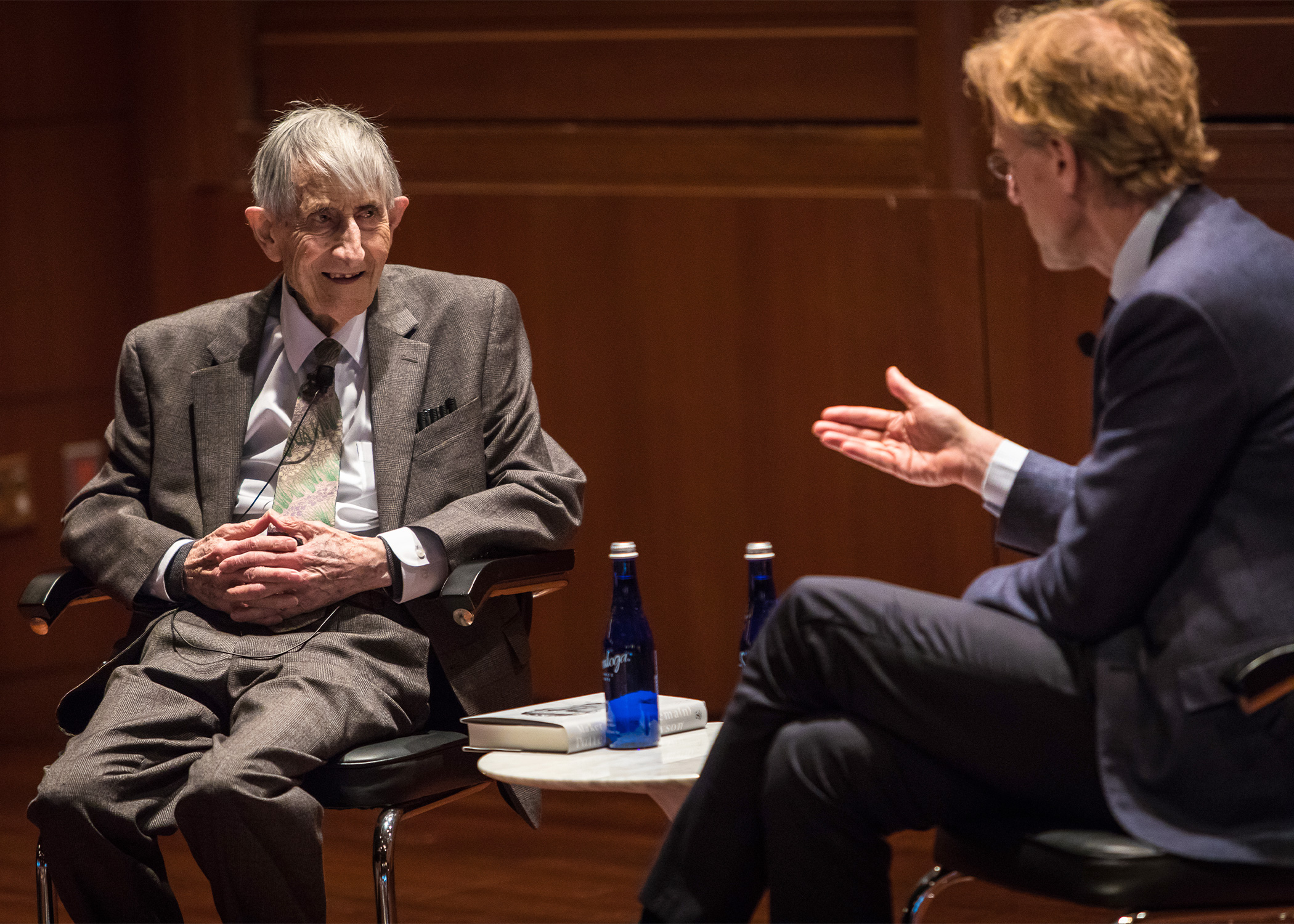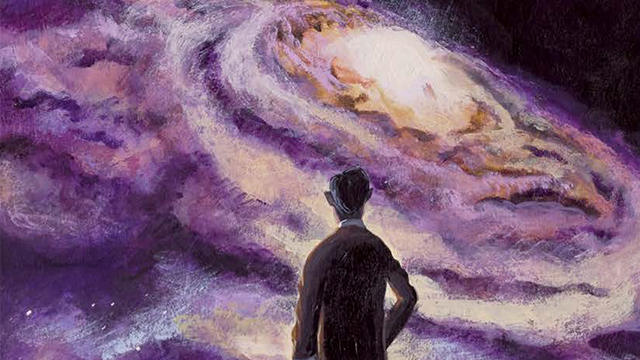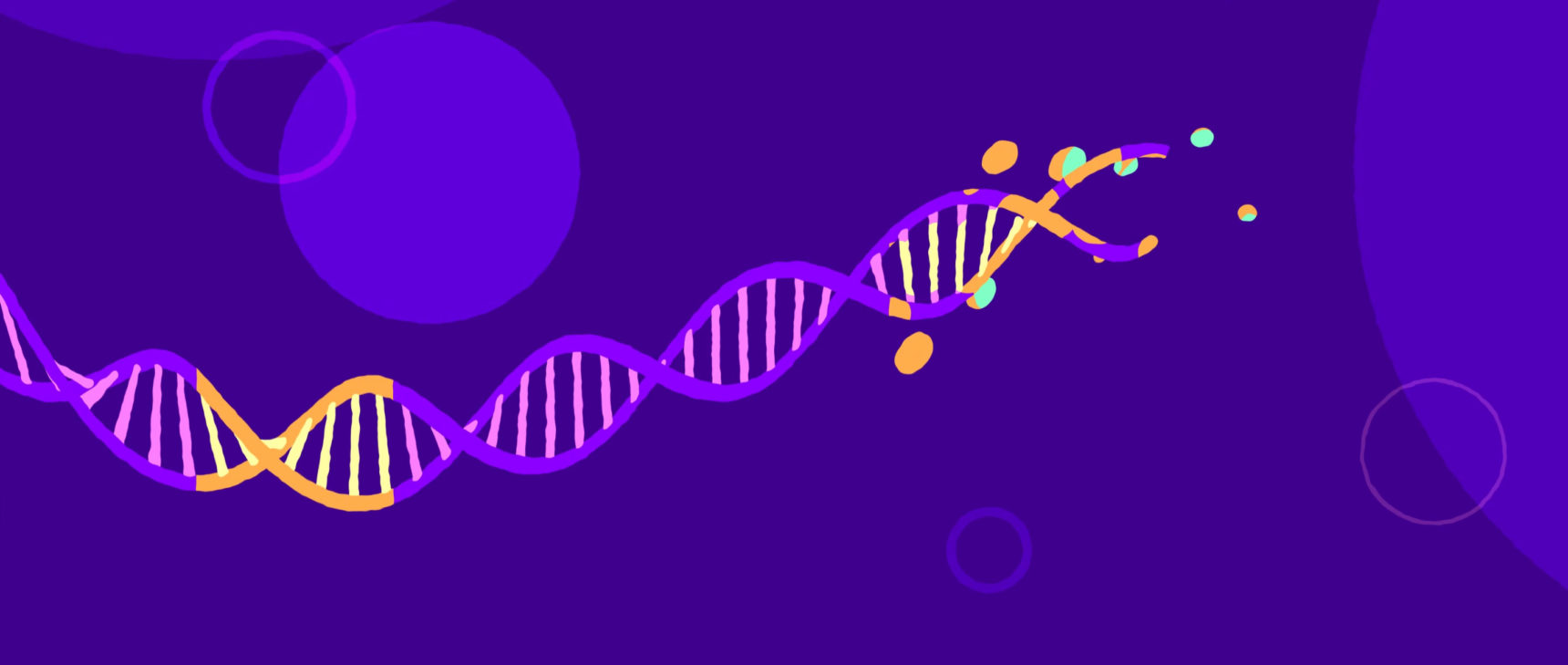Remembering the Unstoppable Freeman Dyson

Freeman Dyson loved exploring new ideas and asking questions.
Dan King/Institute for Advanced Study
Introduction
When Freeman Dyson passed away in February at the age of 96, the world lost one of its most versatile scientists and astute humanists. Trained as a mathematician, Dyson had an appetite for number theory, but his most famous achievement came early as a theoretical physicist, laying out the architecture of modern particle physics. He then moved into the design of nuclear reactors, nuclear-powered space travel, astronomy, astrobiology, climate change and futurism, all while being “a wise observer of the human scene.” He described himself as a frog, not a bird, as he enjoyed jumping from pool to pool, studying their details deeply in the mud. The bird’s-eye perspective was not for him, and he had a lifelong suspicion of grand unified theories.
No life was more entangled with the Institute for Advanced Study, Dyson’s home in Princeton, New Jersey. The English-born scientist came first to the Institute in 1948 as part of an exceptional group of young physicists and mathematicians working with the director, J. Robert Oppenheimer. His colleagues included the future Nobel laureates Hideki Yukawa and Jack Steinberger, as well as Dyson’s first wife, Verena Haefeli, the mother of his eldest children, Esther and George. (In 1958, Freeman married Imme Dyson, a master runner, with whom he had four daughters: Dorothy, Mia, Rebecca and Emily.)
When today’s younger scientists asked Dyson how it felt to be a physicist at the Institute in 1948, in those halcyon days when giants like Albert Einstein and Oppenheimer roamed the grounds, he had great pleasure telling them he wasn’t impressed at all by the famous men. Einstein rarely came to seminars, only when his friend Max von Laue visited, and Oppenheimer did little physics. No, his young colleagues inspired him the most.
It was in his own youth that Dyson had his most celebrated result: the unification of two complementary views of quantum electrodynamics, the theory describing the interaction of light with charged matter. During a postwar visit to the United States, he was fortunate to join the group of young American physicists who had returned from Los Alamos after building the atom bomb. Together, they set their minds on resolving the mysteries of quantum theory. Among them was Richard Feynman, the quirkiest and most brilliant of the bunch. Dyson described him as “half genius and half buffoon.” They made an immediate and lasting connection.

Dyson and Robbert Dijkgraaf shared a conversation at the Institute for Advanced Study in 2018.
Dan Komoda/Institute for Advanced Study
At that time, there were two different approaches toward understanding particle physics. Julian Schwinger at Harvard University had developed a complicated scheme of calculations that was comprehensive, but which few understood. Feynman at Cornell University, on the other hand, had posited a deceptively simple set of diagrams that described the interactions of particles in terms of their trajectories through space and time. In the summer of 1948, while traveling by Greyhound bus from San Francisco to Princeton, Dyson had an epiphany that united the two.
In a flash he understood how Feynman’s straightforward diagrams could perfectly reflect Schwinger’s abstract algebra. A single diagram could in fact be drawn in space and time in many separate ways, interchanging cause and effect, and so each one could capture a whole range of particle behavior. For example, it could describe the emission of a photon by an electron and the subsequent absorption by a second electron, but also the reverse process where the second electron emitted the photon and the first absorbed it. All these processes corresponded exactly with each of the separate calculations in Schwinger’s approach.
It was nothing less than the birth of modern particle physics. Nobel Prizes naturally soon followed — for Schwinger, Feynman and the Japanese physicist Sin-Itiro Tomonaga, who had independently found a third approach. Dyson just missed the boat that by tradition has room for only three passengers, but he often said it was much better when people asked why you didn’t get a Nobel Prize, rather than why you did.
After a brief stay at Cornell, Dyson took up a permanent post at the Institute in 1953, where he stayed until the very end, walking every morning to his office to think and write. A few years into the appointment, he abandoned particle physics. It was time for a jump into a different pool. Dyson threw himself into designing rockets driven by nuclear explosions, a potent means of propulsion. The destination of Project Orion, as the program was known, was nothing less than Saturn — and, eventually, the nearest stars. He was thoroughly disappointed by the limited ambition of visiting only the moon.
Dyson’s off-world research continued through the 1960s. He was one of the first to seriously consider the search for extraterrestrial life, and fantasized about the colonization of the cosmos by self-replicating robots or a “space ark” carrying the genetic material of all terrestrial organisms. This is also when he came up with the notion of a “Dyson sphere”: As a civilization grows technologically, it will try to capture all the energy of a star by surrounding it with a spherical arrangement of orbiting structures. In his own words, he was “obsessed with the future.”
Dyson also returned to his first love, mathematical physics, around this time. He established the theory of random matrices — square arrays of numbers chosen randomly — to categorize the statistics of complex quantum systems. That line of research had a serendipitous application to one of the deepest open problems in mathematics: the behavior of the Riemann zeta function that captures the distribution of prime numbers. During a teatime discussion with the mathematician Hugh Montgomery at the Institute in April 1972, Dyson suggested that the zeroes of the zeta function repel one other in exactly the same way as the energy levels of his random matrices. This has turned out to be a remarkably fertile approach in modern number theory, leading to breakthroughs in various generalizations of the Riemann hypothesis.
Despite this prodigious scientific output, Dyson never bothered earning an actual Ph.D., though he received more than 20 honorary doctorates. As an eternal graduate student, he had license to question everything and everybody. It was his scientific get-out-of-jail card, and he used it fondly and frequently. Always a contrarian, Dyson was orthogonal to many preconceived ideas, sometimes including his own. In fact, here at the Institute we had a local Dyson theorem: If you want Freeman to agree with you, surround him with people who disagree with you.
This tendency also led to Dyson’s taking the contrarian side on some well-established issues, including climate science, to the disappointment of many of his colleagues. While he didn’t deny the role of humans in warming the Earth, he did feel that the models were incomplete and the problem was given too high a priority, not worth the economic cost. He also wrote freely about the roles of magic and religion as ways to approach the world complementary to science, and expressed skepticism about the need for a “theory of everything” in physics. During World War I, Dyson’s father — the eminent British composer Sir George Dyson — wrote the first manual on grenade throwing. His son similarly enjoyed throwing intellectual grenades.
Dyson’s contrarianism ultimately reflected one of his life’s biggest concerns: the importance of diversity. “I look both at scientific and human problems from the point of view of a lover of diversity,” he once wrote. “The preservation and fostering of diversity is the great goal which I would like to see embodied in our ethical principles and in our political actions.” In his own relationships, Dyson was always perfectly happy to be friends with people who disagreed.
In addition to all his scientific frog-hopping, Dyson also jumped into various literary pools, writing extensively for the public. In fact, he was a writer long before he became a scientist. At age 9, he wrote his first work of fiction, Sir Phillip Roberts’s Erolunar Collision, whose plot involved the possibility that the minor planet Eros might collide with Earth. He became well known to a wide audience with his books and many beautiful popular essays. All his writings have a strong personal character and an original angle. During the book tour for his 2018 autobiography, Maker of Patterns, someone asked him, “Professor Dyson, if you could live for another hundred years, what would you work on?” His answer was brief and characteristic: “That is a stupid question. I have a short attention span.”
Dyson always had the remarkable ability to be at the right time at the right place, witnessing or even precipitating many of the 20th century’s biggest scientific events. He was the researcher’s version of Forrest Gump. When I once mentioned this, he said without missing a beat, “But I never met Forrest Gump!”
What was the secret to Dyson’s rich and productive life? I am reminded of the Norton lecture series The Unanswered Question, which Leonard Bernstein gave at Harvard in 1973. His concluding words were, “I’m no longer quite sure what the question is, but I do know that the answer is yes.”
Freeman Dyson said yes to everything — perhaps with the exception of when nobody said no. I witnessed this firsthand at the Institute. In any lecture, seminar, conference, discussion group, play reading, musical performance or children’s lecture, Dyson was there, in the front row with Imme, ready for another jump.




